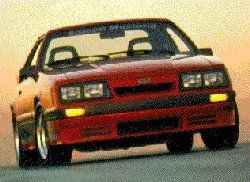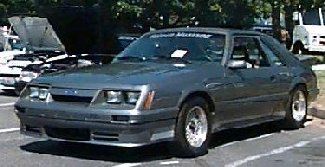 |
 |
|
1984 marked the first year of the now well known, Saleen Mustang. Its success is now well entrenched into the Mustang's history. Powered with the popular 5.0l (302 ci) engines, solid construction, Saleen Racecraft suspension, and wild aerodynamics (for the time), the Saleen was much more than the typical 'aftermarket tuner' add on packages. The modifications were designed to work as a unit, which was succesfully used on the Saleen race cars.
Late in 1983, Steve approched three manufacturers with his idea of creating what would become the future Saleen. The Ford Motor Company, eager to promote the performance image of the Mustang, jumped at the chance of creating the next Shelby Mustang. For the next three and a half years, the factory sponsored Saleen Mustang was constructed at Burch Ford in La Habra, California. The heart of the Saleen was it's 5 liter small block Ford V8 with a 4 barrel carburetor producing 175hp. To maintain the factory warranty, the engine was not modified. Steve was able, though, to modify the Mustang's suspension. Saleen's trademark 'Racecraft Suspension' was added to all Saleens produced. The components were selected after many months of testing both on and off the track. The '84 suspension was made up of specific rate springs in all 4 corners (which lowered the car 1 to 1 1/2 inches), Bilstein shocks and struts, lower crossmember/K member support, self lubricating urethane (Lubrithane) bushings, and Eagle GT P215/60HR15 tires on 15x7 Hayashi gold mesh wheels.
The Saleen Mustang made its debut in June 1984 at Sears Point Raceway, displaying both his Saleen Mustang Trans-Am race car and it's sister street car. Steve recieved his first two orders on that day (a total of 3 1984 Saleens were produced). Saleen used #32 to promote his cars to Ford dealers across the country. All orders taken during the Summer of '84 were filled with '85 Saleens. Imagine for only $14,300, you could have had a car as close to a real race car as possible. The Saleen Mustang is about to become a legitimate supercar CONTINUE ... This site is not sponsored or supported by Saleen, Inc. |
|
© 2007 Stangranch.com and M. Jones -- All Rights Reserved Pages Created By Marty Jones This site uses Dreamweaver and Paint Shop Pro |
 Just like Caroll Shelby, creator of the Shelby Mustang, Steve Saleen was a racing driver. Steve, ironically, raced a 1966 Shelby GT-350 in the early '70s, and in 1975, he was a regional champion in the B production series. By 1982,he entered the SCCA Trans-Am Championship which led to his interest in the showroom stock series. His years of racing expertise enabled him to create the ultimate street car.
Just like Caroll Shelby, creator of the Shelby Mustang, Steve Saleen was a racing driver. Steve, ironically, raced a 1966 Shelby GT-350 in the early '70s, and in 1975, he was a regional champion in the B production series. By 1982,he entered the SCCA Trans-Am Championship which led to his interest in the showroom stock series. His years of racing expertise enabled him to create the ultimate street car. The car also had 'crusing' appeal. A deep three piece front air dam styled after the stock '79 Pace Car/'82 GTs, a large rear spoiler, and side skirts and rear wheel spats. To highlight the Saleen's lines, a three color band of stripes where adhered along the side of the car below the molding (the first Saleen, #32, had it's stripes painted on). The added on body panels were there for much more than looks; they were functional. The parts were wind tunnel tested at Lockeed and track tested at Willow Springs. This testing allowed Saleen to better use these parts for high speed and lateral stability, top speed, and fuel economy. The agressive look of the Saleen made the Mustang GT pale in comparison.
The car also had 'crusing' appeal. A deep three piece front air dam styled after the stock '79 Pace Car/'82 GTs, a large rear spoiler, and side skirts and rear wheel spats. To highlight the Saleen's lines, a three color band of stripes where adhered along the side of the car below the molding (the first Saleen, #32, had it's stripes painted on). The added on body panels were there for much more than looks; they were functional. The parts were wind tunnel tested at Lockeed and track tested at Willow Springs. This testing allowed Saleen to better use these parts for high speed and lateral stability, top speed, and fuel economy. The agressive look of the Saleen made the Mustang GT pale in comparison.